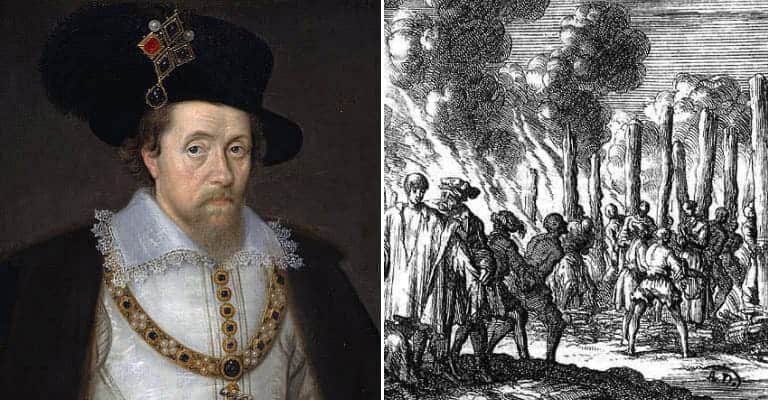Scotland was one of the most active areas to persecute witchcraft between the fifteenth and eighteenth centuries. Over this period, it is estimated that that around 4,000 people were burnt at the stake. However, the most ardent persecutions occurred during the late sixteenth and early seventeenth century. During this period, any witchcraft- whether it was of good or evil intent became unacceptable. A witch was a witch; bound by a pact to act as an agent of the devil – even if they were using their magic to heal rather than harm.
Before long, this hardened attitude to witchcraft had spread south to England. This change in perspective- and its spread- can be attributed one man: James VI of Scotland, later James I of England. In 1589, a stay in Denmark led to James’s conviction that witchcraft was real. This sojourn abroad- and the King’s journey home marked the beginning of a long obsession which saw James becoming the Witchfinder King as he took an active interest in rooting out witches- even writing a manual on the subject that was used by Matthew Hopkins, the self-styled Witchfinder general. However, the paranoia and superstition that inspired James’s fear of witchcraft began before Denmark and can be traced back to James’s early youth.

Igniting Superstition: Mary Queen of Scots Death and a Visit to Denmark
James VI became King of Scotland in 1567 while he was still a baby. His mother, Mary Queen of Scots, had been forced to abdicate the throne, so while a succession of regents ruled Scotland, tutors reared the infant King. Chief amongst these was George Buchanan, a strict Presbyterian. Buchanan aimed to ensure that his royal charge had no truck with Catholic superstitions. He was partially successful. For James grew up to be a staunch Protestant. However, while the young King was also learned and intelligent, he also possessed with a distinctly superstitious streak.
This superstitious tendency manifested itself at the time of the death of James’s mother, Mary Queen of Scots. At this time, James was 21 and had been ruling Scotland independently for six years. Many years later, James told Sir John Harington, one of his trusted nobles at the English court about how he believed Mary’s death had been ‘foreshadowed” at this time. “His Highness told me her death was visible in Scotland before it did really happen,” said Harington, “being, as he said, spoken of in secret by those whose power of sight presented to them a bloody head dancing in the air. He then did remark much on this gift and said he had sought out of certain books a sure way of attaining knowledge of future chances.”
So, James’s superstitious nature might have provided fertile ground in which a fear of witchcraft might grow. However, the seeds of that fear did not originate in Scotland. For Buchanan and other protestant intellectuals of the time may have been staunchly anti-catholic, but for them, witchcraft was not a problem. Instead, James’s witchcraft issues began to blossom during a trip to Denmark in 1589. That August, James had been married by proxy to Anne of Denmark. However, when the Princess attempted to set sail for Scotland to formalize her marriage, she found herself driven back to shore by violent storms. So, James decided not to wait for his bride to come to him and instead set sail for Denmark.

The couple remained in Denmark until May 1590. During that time, James met many intellectuals and philosophers of the Danish Court. What the Scottish King learned gave him much food for thought. For James became aware that belief in witchcraft was widespread in Denmark. The Danish firmly believed that all witches were in league with the devil and that their powers came from a demonic pact. Witches were regarded as a social scourge and widely hunted. Crucially, however, James learned that the court believed the storms that had prevented his new wife crossing the sea to Scotland were the work of witches.
So, with these thoughts fermenting at the back of his mind, James embarked on the voyage back to Scotland with his new bride. While the royal fleet was at sea, violent storms suddenly blew up. The storm battered the Scottish fleet, and one ship was lost. Shaken by what had happened and troubled by the ideas seeded in his head during his stay in Denmark, James grew convinced that witches were at work- not just in Denmark but in Scotland too.

